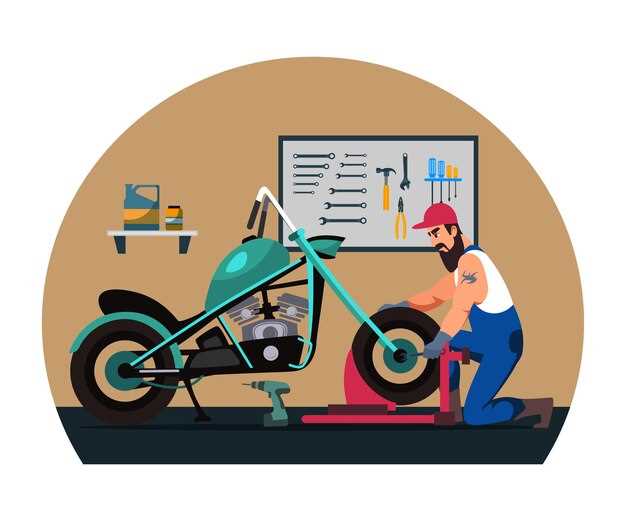Check your tire pressure regularly to ensure optimal performance and safety on the road. Maintain proper inflation according to your motorcycle’s specifications, usually found in the owner’s manual. Under-inflated tires can lead to poor handling and increased wear, while over-inflated tires may cause a harsh ride and the risk of blowouts.
Change the oil and oil filter at recommended intervals. Fresh oil keeps your engine running smoothly, removes contaminants, and enhances longevity. Use the oil type specified by your manufacturer for best results. Always allow the bike to cool down before starting the oil change process to avoid burns.
Inspect the chain tension and lubrication consistently. A well-maintained chain enhances the bike’s responsiveness and reduces the chance of wear and damage to the sprockets. Use appropriate lubricant and clean the chain regularly to prevent rust and dirt buildup.
Pay attention to brake pads and fluid. Check for wear on the pads and change them if they are thin. Ensure the brake fluid is at the correct level and replace it if it appears dark, which indicates contamination. Fresh brake fluid improves responsiveness and safety.
Keep an eye on the battery condition. Clean the terminals and ensure tight connections. Test the voltage regularly, especially before long rides. A weak battery can lead to starting issues and leave you stranded.
Finally, always check your lights and signals before each ride. Functioning lights ensure visibility to other drivers and enhance your safety. Replace burned-out bulbs immediately to avoid any legal issues while riding.
Checking and Maintaining Tire Pressure
Check tire pressure before every ride. Use a reliable tire pressure gauge to measure the psi (pounds per square inch). Ensure the tires are cold for an accurate reading, as heat from riding can increase pressure temporarily.
Refer to the owner’s manual or the manufacturer’s sticker, usually found on the frame or swingarm, for the recommended psi. For most motorcycles, the ideal range is between 28 to 40 psi, depending on the model and load.
If the pressure is low, inflate the tires using an air compressor. Fill them gradually, frequently checking the gauge to avoid overinflation. If the pressure is too high, release air slowly until it reaches the recommended level.
Remember to inspect tires regularly for signs of damage such as cuts, cracks, or punctures. Look for uneven wear patterns, which may indicate alignment issues or insufficient pressure.
Perform these checks at least once a week, or more often if riding conditions change significantly. Consistent monitoring enhances safety and improves tire lifespan.
Understanding Oil Change Intervals and Procedures
Change your motorcycle’s oil every 3,000 to 5,000 miles, depending on the manufacturer’s recommendations and the type of oil used. Synthetic oil may allow for longer intervals, while standard oil may require more frequent changes. Always consult your owner’s manual to determine the specific requirements for your motorcycle.
To perform an oil change, gather your tools: a wrench, a drain pan, an oil filter wrench, and fresh oil. Start by warming up the engine for a few minutes to thin out the oil, making it easier to drain. Turn off the engine, ensure the motorcycle is upright, and place the drain pan under the oil pan.
Next, remove the oil drain plug with a wrench, allowing the old oil to flow into the pan. Once it has fully drained, replace the drain plug and tighten it securely. Use an oil filter wrench to remove the old oil filter, applying a thin layer of new oil to the rubber seal of the new filter before installing it.
Now, pour in fresh oil, checking the level with the dipstick or sight glass. Add oil until it reaches the appropriate level, then run the engine for a few minutes to circulate the oil and check for leaks. Shut off the engine and recheck the oil level, topping off if necessary.
| Oil Type | Change Interval |
|---|---|
| Conventional Oil | 3,000 miles |
| Synthetic Oil | 5,000 miles |
| Oil Filter Change | With every oil change |
Dispose of the old oil and filter at a recycling center. Regular oil changes not only enhance performance but also extend the life of your motorcycle. Adopting this maintenance routine guarantees a smoother and more reliable ride.
Inspecting and Replacing Motorcycle Chains
Check the motorcycle chain regularly for signs of wear, such as rust, excessive lubrication on the links, or noticeable stiffness. Use a tension gauge to ensure proper tension; the chain should have a slight amount of play but not be overly loose or tight. Inspect the chain for any kinks or tight spots, as these can affect performance.
To determine if the chain needs replacement, measure its elongation. A chain is generally worn out when it exceeds 1% elongation. Use a chain wear tool or a ruler for precise measurement. If the chain has stretched beyond this point, it’s time for a new one.
Replacing a motorcycle chain involves a few steps. First, raise the motorcycle on a secure stand for stability. Remove the rear wheel by loosening the axle nut, then take off the wheel. Use a chain breaker tool to remove the old chain. If the chain is riveted, you will need to grind off the pins before removal.
Install the new chain by threading it through the rear sprocket and connecting it to the front sprocket. Ensure the chain is properly aligned and has the right tension. Reinstall the rear wheel, tighten the axle nut, and check the alignment before lowering the motorcycle back to the ground.
After installation, take a short test ride to ensure the chain is functioning correctly. Recheck the tension and alignment once you’ve completed the ride to make any necessary adjustments. Regular maintenance of your motorcycle chain prolongs its life and enhances overall performance.
Cleansing and Lubricating Air Filters
Regularly cleanse your air filters to maximize engine performance and prolong its lifespan. Start by removing the air filter from the motorcycle. Check the owner’s manual for specific instructions related to your model.
Using compressed air, gently blow out dirt and debris from the filter while holding it away from the bike. This method is quick and efficient for foam-type filters. For paper filters, consider using a soft brush to remove dust particles without damaging the material.
If your filter is heavily soiled or has not been cleaned in a while, wash it with warm, soapy water. Rinse thoroughly until all soap is removed. Allow it to dry completely before reinstallation. Avoid using solvents or harsh chemicals, as they can damage the filter material.
Once dry, apply a specialized filter oil to foam-type filters. Use an even coating and ensure the oil penetrates all parts of the foam. Squeeze out any excess oil to avoid over-saturation. For paper filters, no oil is needed; simply reinstall it once clean.
Before putting everything back together, inspect the air filter housing for any debris or obstructions. Clean the area carefully, ensuring it’s free from dirt. After reassembly, keep an eye on the filter condition during regular maintenance checks. Make this procedure a part of your routine to keep your motorcycle running smoothly.
Cleaning and Adjusting Brake Systems
Regularly clean brake components to ensure optimal performance. Begin by removing the brake pads. Use a soft brush or a damp cloth to wipe away dust and debris from the calipers and rotor. Avoid using harsh chemicals that can damage the braking surfaces. If necessary, a bit of isopropyl alcohol can help to remove stubborn grime.
After cleaning, inspect the brake pads for wear. Look for uneven surfaces or grooves. If they are worn down, replace them to maintain effective braking power. For hydraulic systems, check the brake fluid level. Top off with the manufacturer-recommended brake fluid type, and if the fluid appears dark or contaminated, perform a full flush of the system.
Adjusting brake systems is equally important. For rim brakes, ensure the pads contact the rim evenly. Adjust the position of the pads using the provided screws. Squeeze the brake lever and inspect alignment–make adjustments as needed until the pads make full contact without rubbing the tire.
For disc brakes, check the alignment of the caliper over the rotor. Adjust the caliper position if necessary, ensuring that it is centered. Pull the brake lever and observe if the rotor spins freely. If the rotor rubs against the pads, use the adjustment screws to realign it.
Lastly, always test the brakes after cleaning and adjustments. Spin the wheel and squeeze the lever to see how the system responds. If everything feels right, you’re good to go. Regular maintenance keeps your brakes responsive and safe.
Setting Up a Regular Maintenance Schedule
Create a detailed maintenance calendar. Identify key tasks such as oil changes, tire checks, and brake inspections. Write down when these tasks should happen based on mileage or time intervals.
- Oil Change: Change the oil every 3,000 to 5,000 miles or every six months, whichever comes first.
- Tire Pressure: Check tire pressure at least once a month. Adjust to recommended levels before every ride.
- Brake Inspection: Inspect brake pads every 2,000 to 3,000 miles and replace them when they get close to the wear limit.
- Chain Maintenance: Clean and lubricate the chain every 500 miles. Inspect for wear or damage regularly.
- Coolant Levels: Check coolant levels before each riding season and top up as needed.
Use tools like spreadsheets or maintenance apps to keep everything organized. Set reminders for each maintenance task. This ensures you don’t overlook any crucial checks.
Consider seasonal preparations. Before winter, clean the bike thoroughly, change the oil, and store it properly. Before summer, inspect battery health and fluids.
Document all maintenance performed. Record dates and any parts replaced. This log helps track patterns and plan for future services.
Incorporate pre-ride inspections into your routine. Check lights, signals, and brakes to ensure everything functions correctly. This daily habit enhances safety and bike longevity.
Regular maintenance elevates your riding experience and extends your motorcycle’s lifespan. Commit to your schedule and watch your bike thrive.







